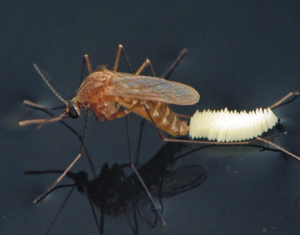Attacking mosquitos are spoilers for our outdoor activity interests this time of year. Hurricanes and other storm events tend to be a catalyst that increases these populations. Not only are mosquitos a nuisance, but they are carriers of several diseases. But, there are ways to control these annoying pests and get some relief.
Mosquito populations can be divided into two categories: floodwater mosquitoes and standing water mosquitoes.
Floodwater mosquitoes need water to lay their eggs, and the eggs also need to dry out before hatching during a storm event. Moist areas like pastures, planting furrows, salt marshes and swales are prime habitat. If you look close, the eggs can be found in cracks in the soil. Again, stormy rains and surge act as a catalyst for these eggs to hatch. So, what is the approximate estimate of mosquito eggs per acre in floodwater habitat in Florida? Scientist estimate 700,000 to 1.3 million eggs per acre. And yes, that’s per acre. Unfortunately, small scale efforts to reduce standing water around properties have little effect on control.
Figure 1. Standing water mosquito and eggs (Culex quinquefasciatus).
Credit: S. McCann, UF/IFAS/FMEL.
On the other side of the coin, standing water mosquitos need,…you guessed it, standing water to lay their eggs. These mosquito eggs cannot withstand drying out, therefore cannot hatch into larva. Females lay eggs on the surface of water with a hatching time of around 24 hours. The larva to pupae to adult stage happens quickly in mosquitoes, and the thirst for blood is not far behind. After a female finds a blood source, the cycle starts all over again. Only the females have biting mouth parts. Both male and female mosquitoes feed on the nectar of flowers. It’s the female mosquitoes that usually need a blood meal to insure mature eggs.The combination of the two groups of mosquitoes provide for a double whammy put in place by a storm. When dry areas flood, floodwater mosquito eggs hatch. When floodwater has nowhere to go, standing water mosquitoes have an abundance of places to lay eggs.
Unfortunately, some diseases can be transmitted by mosquitoes, such as west nile virus, eastern equine encephalitis and even heart worms in dogs. So, what can be done to combat these pests around your property? Reducing the amount of standing water helps dramatically, especially, dumping water holding containers. Cleaning debris from rain gutters too, can help as water can collect in blocked gutters. Mineral or cooking oil can be added to standing water and rain collection devices, as the oil forms a thin film on the surface of the water which causes larvae and pupae to drown. This is also a good control method with plant containers that collect water. Mosquito biological controls, like Bt (Bacillus thuringiensis) are helpful and will not harm pets or livestock. These products can be used in fish habitats, animal water troughs, bird baths, rain barrels, roof gutters and tree holes, just to name some. Please read precautionary statements and manufacturer application directions before use. Rain gardens are also very beneficial in suppressing standing water. If you have an area of your property that is known for water holding capacity, be sure to plant water loving plants in that area.
For more information please contact your local county extension office.
Supporting information for this article can be found in the UF/IFAS EDIS publication: “Hurricanes and Mosquitos” by C. Roxanne Connelly: https://edis.ifas.ufl.edu/pdffiles/IN/IN53500.pdf
UF/IFAS Extension is an Equal Opportunity Institution.
- More Information on Establishing Cool Season Wildlife Food Plots in the Panhandle - November 21, 2024
- Upcoming Event: Panhandle Outdoors Live at St. Joseph Bay on June 21st! - June 3, 2024
- Panhandle Outdoors Live: Woodlot Management - March 11, 2024

